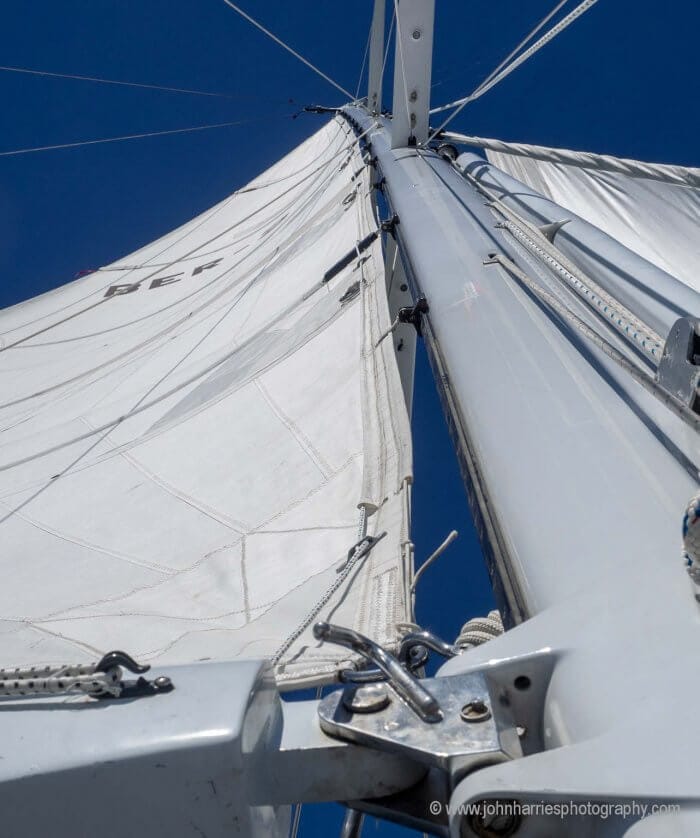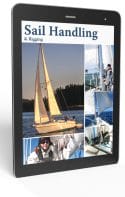
To recap, in Parts 1 to 4 we:
- Centred the rig athwartships—Part 1.
- Set the rake—Part 3.
- Set the prebend—Part 3.
- Chocked the mast at the partners (keel stepped only)—Part 4.
- Set the backstay/forestay to sailing tension—Part 4.
Now it’s finally time to go sailing and finish our tuning job. The good news is that, because we did such a great job before sailing and really understood what we were doing instead of just guessing or following a bunch of rules of thumb, this part is going to be easy, rather than the perplexing struggle that the sailing tune can degenerate into if the basics are not right.
In fact, all we need to do is:
- Tighten the shrouds to sailing tension
- Straighten the mast in the athwartship plane while sailing.
Easy-peasy, and should not take more than a couple of hours.


You didn’t address mast “pumping”, which is a problem that occurs with the springy masts of some race/cruisers. What does it indicate, and how to deal with it?
A good observation position for mast performance under challenging conditions (i.e. plus/minus 20 kts) is beneath the V berth hatch, which, on many boats is positioned in a way that affords a comfortably dry and stable observer a perfectly centered view of mast and shrouds to check dynamic tuning
Reed Erskine s/v Cayenne
Hi Reed,
If we do the full tune as I have detailed in the last five chapters, the mast will not pump. Pumping is almost always an indication of a poor tune , usually by getting the prebend wrong.
As to sighting the mast from under the forehatch, I don’t think that will work on most boats since the mast has prebend and rake and therefore it’s hard to sight from anywhere other than aft and at the gooseneck, as I’m doing in the photo.
Hi Again, Reed,
I should add to the above on pumping, that I’m assuming the mast is properly stayed. If, on the other hand, a mast has no baby stay, staysail stay, runners, or fore and aft lowers, it will tend to pump in big seas offshore, pretty much no matter how we tune it, although getting a good tune will help. This is why I’m repeatedly on record as saying that all offshore boats should have some sort of internal head stay and runners.
John, we have running backstay tangs on our cutter’s deck-stepped mast (and somewhere in a box are the running backstays), but we’ve yet to install them as we have two fixed backstays to the stern quarters and I haven’t seen the need. We soon will, however, see the need. Do you know of a reference which drills down to the right time and method to use running backs? I’m not seeing a lot of literature on the topic, although I may be posing the search query incorrectly.
Hi Marc,
First off, permeant backstays and runners have different functions, so having one does not remove the need for having the other.
If you have a really stubby and stiff single spreader rig with fore and aft lowers you might get away without runners, but otherwise an internal head stay of some kind and runners should be rigged any time any sailboat goes offshore where large swells may be encountered. The function is to stop the mast pumping forward and aft in the middle on each wave and generally stiffen things up. Of course on a cutter, the added function is to oppose the staysail stay loads.
The windward runner should be set up whenever the wind/swell is forward of the beam.
Look around any anchorage where offshore cruisers congregate: the more experienced the owner the more likely it is that runners will be installed… and the bigger the anchor.
The added advantage of runners and an internal head stay, even on a sloop, is that the said head stay is a far better place to set a storm jib than the fore stay.
Thank you for the replies, John. I guess I’ll dig them out and rig them.
Hi John,
Four comments on the topic “rig tuning under sail” (great article by the way)
Forty eight comments on the topic “reducing generator run time.”
Do I sense an expression of priorities here?
Speaking of priorities, I just looked at an owner built Fraser 41* that is the perfect example of what happens when a craftsman designs and builds a boat without sailing across an ocean first.
** Beautiful built-in piano and desk along the stbd. side of the salon.
** Sea berths deleted in favor of artistic curved seating.
** Full length valances along the trunk cabin sides to contain full length curtains for marina privacy.
** Complete absence of handholds inside and out (the builder must have gone to a boat show and copied the work of an Interior Desicrator who designed the interior of a 2018 production sailboat.)
** Transom and companionway sill cutaway to a 2″ high sill leading to the interior
* For those of you who are not Canadian, the Fraser 41 is a design that is similar to a Gen II Valiant 40, rarely has blisters, and good ones often come on the market in the low 50 USD’s. A lot of owner-builds– some great and some ordinary. Poor man’s Adventure 40?
Hi Richard,
I too have noticed the priorities that seem to be indicated by the number of comments. Worrying I think, since I can’t imagine anything, let alone gen run time, as important as tuning the mast right. And thanks for the kind words.
On the Fraser, despite being a (new) Canadian, I didn’t know anything about them. Just took a very quick look and I agree, looks like a wholesome boat. As to the one you saw, I too have seen over-crafted boats. Usually means that the owner was a lot more about boat building than actual going anywhere. Nothing wrong with that I guess, but it does result in a boat that’s really not much use.
I think there are 60+ Fraser 41’s afloat and voyaging throughout the Pacific.
Super series, John. Wish I’d known all this thirty years ago – I would have got an unstayed mast sooner!
My mast is 48’ long on a 39’ German Frers Dufour design, with double spreaders, straight. When heeling 20-25 degrees, usually at about 20-22 kn apparent wind (next time I’ll read the true wind!) the masthead is sagging off leeward by about the mast width. This is has worried me for a long time. At some point I even though I needed to increase the cap shroud tension, but what ever testosterone I used, this did not help! So I went back to the more normal firm tension. You seem to think that all things considered equal this is rather a no worries. Do you have any more hint as how much is acceptable? There is almost no literature about this. The best I ever read was « the masthead can go gently leeward ». How much is gently ?
Hi Phil,
First off, a mast width of sag is probably not a problem. But, as you found, tightening the caps is not going to fix it.
That said, there is something out of wack since it’s perfectly possible to get the mast straight in that kind of wind: probably about 17 knots true.
However, without being on the boat, there is no way for me, or anyone else, to tell you what the problem is, or how to correct it. And even if I came sailing with you, I would not guarantee to diagnose it since there are so many variables.
So, unfortunately there’s only one right way to sort this out which is to start from scratch, with the first tuning chapter.
I know that’s not good news, but if you just start changing other stuff without starting from scratch you risk making it worse or even doing damage.
Hi John.
If I initially set all the shrouds to eliminate wow, but then when sailing, set the lee shrouds to “just firm”, won’t that re-introduce a wow on the opposite tack or when not sailing?
I think I see the answer to my own question, but it is non-intuitive (to me at least). I had to re-read Illustrated Sail and Rig Tuning by Ivar Dedekam pages 71-76 where he talks about tuning the rig under sail, and then especially page 78, where he talks about pre-tensioning the cap shrouds and why this is necessary to prevent shock loading the rigging.
Hi Ben,
Yes, the first step of tightening the cap shrouds progressively on each side will result in a bend to leeward in the middle. That’s why I explain how to take that out under “Now we need to get the mast straight again by setting the lowers and intermediates.”
I also cover why the shrouds should not be loose above under “safer that slack”.
Anyway, glad it’s now clear. Often reading another author on the same subject helps to clarify things for me too.